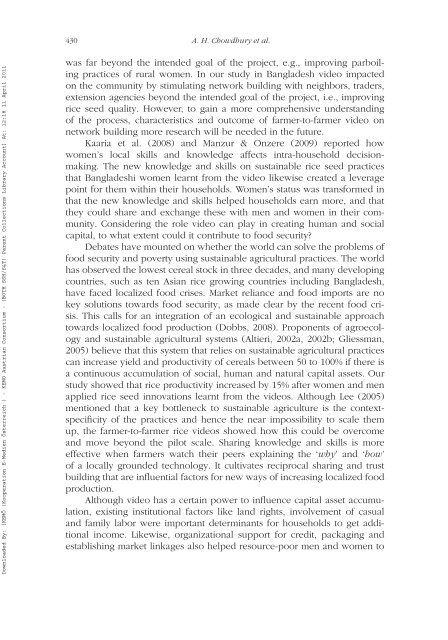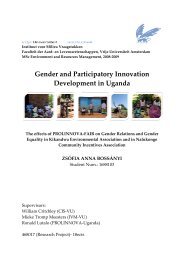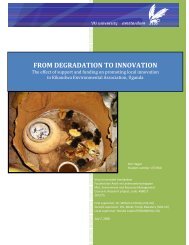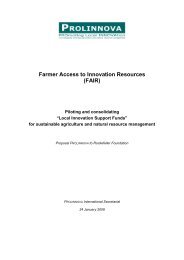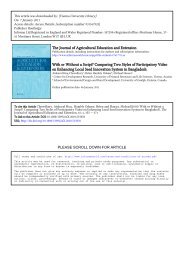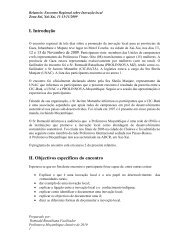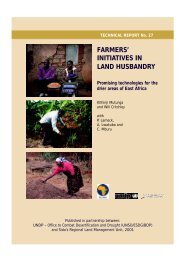Chowdhury et al (2011); PDF file - Prolinnova
Chowdhury et al (2011); PDF file - Prolinnova
Chowdhury et al (2011); PDF file - Prolinnova
You also want an ePaper? Increase the reach of your titles
YUMPU automatically turns print PDFs into web optimized ePapers that Google loves.
430 A. H. <strong>Chowdhury</strong> <strong>et</strong> <strong>al</strong>.<br />
Downloaded By: [KEMÖ (Kooperation E-Medien Österreich ) - KEMO Austrian Consortium - (BOTH SSH/S&T) Parent Collections Library Account] At: 12:18 11 April <strong>2011</strong><br />
was far beyond the intended go<strong>al</strong> of the project, e.g., improving parboiling<br />
practices of rur<strong>al</strong> women. In our study in Bangladesh video impacted<br />
on the community by stimulating n<strong>et</strong>work building with neighbors, traders,<br />
extension agencies beyond the intended go<strong>al</strong> of the project, i.e., improving<br />
rice seed qu<strong>al</strong>ity. However, to gain a more comprehensive understanding<br />
of the process, characteristics and outcome of farmer-to-farmer video on<br />
n<strong>et</strong>work building more research will be needed in the future.<br />
Kaaria <strong>et</strong> <strong>al</strong>. (2008) and Manzur & Onzere (2009) reported how<br />
women’s loc<strong>al</strong> skills and knowledge affects intra-household decisionmaking.<br />
The new knowledge and skills on sustainable rice seed practices<br />
that Bangladeshi women learnt from the video likewise created a leverage<br />
point for them within their households. Women’s status was transformed in<br />
that the new knowledge and skills helped households earn more, and that<br />
they could share and exchange these with men and women in their community.<br />
Considering the role video can play in creating human and soci<strong>al</strong><br />
capit<strong>al</strong>, to what extent could it contribute to food security?<br />
Debates have mounted on wh<strong>et</strong>her the world can solve the problems of<br />
food security and poverty using sustainable agricultur<strong>al</strong> practices. The world<br />
has observed the lowest cere<strong>al</strong> stock in three decades, and many developing<br />
countries, such as ten Asian rice growing countries including Bangladesh,<br />
have faced loc<strong>al</strong>ized food crises. Mark<strong>et</strong> reliance and food imports are no<br />
key solutions towards food security, as made clear by the recent food crisis.<br />
This c<strong>al</strong>ls for an integration of an ecologic<strong>al</strong> and sustainable approach<br />
towards loc<strong>al</strong>ized food production (Dobbs, 2008). Proponents of agroecology<br />
and sustainable agricultur<strong>al</strong> systems (Altieri, 2002a, 2002b; Gliessman,<br />
2005) believe that this system that relies on sustainable agricultur<strong>al</strong> practices<br />
can increase yield and productivity of cere<strong>al</strong>s b<strong>et</strong>ween 50 to 100% if there is<br />
a continuous accumulation of soci<strong>al</strong>, human and natur<strong>al</strong> capit<strong>al</strong> ass<strong>et</strong>s. Our<br />
study showed that rice productivity increased by 15% after women and men<br />
applied rice seed innovations learnt from the videos. Although Lee (2005)<br />
mentioned that a key bottleneck to sustainable agriculture is the contextspecificity<br />
of the practices and hence the near impossibility to sc<strong>al</strong>e them<br />
up, the farmer-to-farmer rice videos showed how this could be overcome<br />
and move beyond the pilot sc<strong>al</strong>e. Sharing knowledge and skills is more<br />
effective when farmers watch their peers explaining the ‘why’ and‘how’<br />
of a loc<strong>al</strong>ly grounded technology. It cultivates reciproc<strong>al</strong> sharing and trust<br />
building that are influenti<strong>al</strong> factors for new ways of increasing loc<strong>al</strong>ized food<br />
production.<br />
Although video has a certain power to influence capit<strong>al</strong> ass<strong>et</strong> accumulation,<br />
existing institution<strong>al</strong> factors like land rights, involvement of casu<strong>al</strong><br />
and family labor were important d<strong>et</strong>erminants for households to g<strong>et</strong> addition<strong>al</strong><br />
income. Likewise, organization<strong>al</strong> support for credit, packaging and<br />
establishing mark<strong>et</strong> linkages <strong>al</strong>so helped resource-poor men and women to


